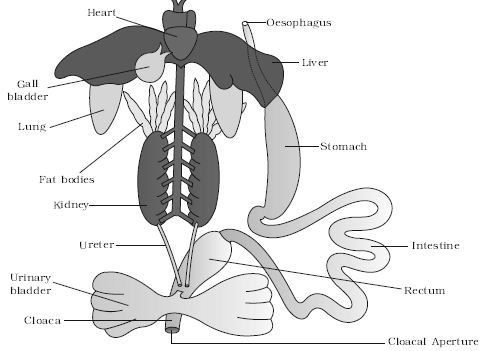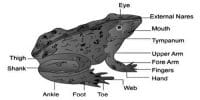Anatomy of Frog: The body cavity of frog accommodates different organ systems such as digestive, circulatory, respiratory, nervous, excretory and reproductive systems with well developed structures and functions (Figure). The digestive system consists of alimentary canal and digestive glands. The alimentary canal is short because frogs are carnivores and hence the length of intestine is reduced.

Figure: Diagrammatic representation of internal organs of frog showing complete digestive system
The mouth opens into the buccal cavity that leads to the oesophagus through pharynx. Oesophagus is a short tube that opens into the stomach which in turn continues as the intestine, rectum and finally opens outside by the cloaca. Liver secretes bile that is stored in the gall bladder. Pancreas, a digestive gland produces pancreatic juice containing digestive enzymes.
Food is captured by the bibbed tongue. Digestion of food takes place by the action of FIC1 and gastric juices secreted from the walls of the stomach. Partially digested food called chyme is passed from stomach to the first part of the intestine, the duodenum. The duodenum receives bile from gall bladder and pancreatic juices from the pancreas through a common bile duct. Bile emulsifies fat and pancreatic juices digest carbohydrates and proteins.
Final digestion takes place in the intestine. Digested food is absorbed by the numerous finger-like folds in the inner wall of intestine called villi and microvilli. The undigested solid waste moves into the rectum and passes out through cloaca. Frogs respire on land and in the water by two different methods. In water, skin acts as aquatic respiratory organ (cutaneous respiration). Dissolved oxygen in the water is exchanged through the skin by diffusion.












